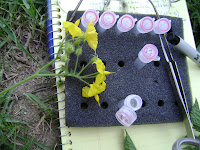Primer día de expedición. Destino Rio Luria.
Alquilamos una furgoneta que en principio fue mas pequeña de lo que esperábamos, por lo que tuvimos que reducir las dos enormes cajas de supplies de muestreo a una sola y acoplar entre los pies las cajas de corcho que llevábamos para recogida de muestras. Aunque salimos temprano, el tráfico en Lima es intenso, todo el mundo va rápido buscando huecos entre carriles...de locura; por suerte, alquilamos la furgoneta con conductor, que se llama Carlos y nos va a acompañar a lo largo de todos estos días de viaje. Una vez llegamos a la zona del Rio Luria, todos estábamos pendientes de lo que había en el monte, buecando tomates desde la furgoneta que, hay que decirlo, incluso por esos carriles marchaba rapidito. Roger iba en la delantera y es capaz de reconocer no solo si es una planta de tomate lo que parece haber a unos metros de distancia, sino la especie de Solanum, bien habrochaites, pennellii o peruvianum entre otras, por el tamaño e intensidad de color de la flor desde lo lejos. Nuestra primera parada fue en Sisicaya, en una zona pedregosa y seca donde encontramos una gran población de S.pennellii en floración pero sin fruto alguno. Probamos allí el Vacai o Guaba en un árbol cercano que había en el camino; son como unas vainas grandes similares a las algarrobas (según lo que yo conozco) pero que en su interior contienen unas grandes semillas negras rodeadas de los que sería el fruto, mucilaginoso, blanco y dulce. La segunda parada fue casi forzosa pues nos topamos de frente con un autobus que venía en direccciòn contraria y con un coche en medio que no pretendía moverse y a la mínima se encaró casi con nuestro chofer discutiendo quién debía retroceder; tras unos momentos de tensión todos bajamos d la furgoneta y, como no hay mal que por bien no venga, descubrimos hasta 3 especies diferentes de tomates silvestres en esa zona: pimpinelifollium, pennellii y cornemullierae. Etiquetamos algunas plantas para recogida de material: pollen, pistilos y hojas para posterior extracción de DNA y RNA entre otras cosas.
El tiempo pasó rñapido entre una cosa y otra, y con la emoción de la aventura, los kilómetros por aquellos carriles y la gran distancia hasta los pueblos mas cercanos, no encontramos donde almorzar; un par de paquetes de patatas y de frutos secos nos surtieron hasta la hora de la cena.
Esa noche, después de la cena empezamos las reuniones de grupo referente al proyecto, algo cansados pero satisfechos por el éxito del primer día de expedición.











































 Roger with some huge
Roger with some huge 








